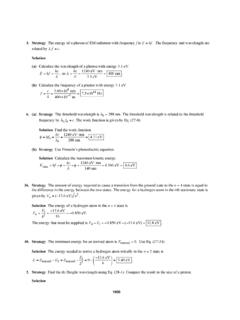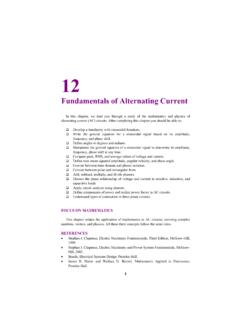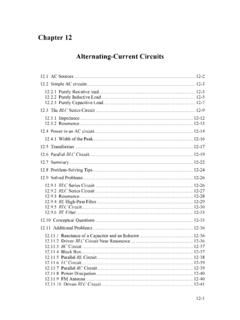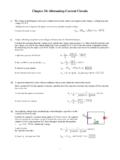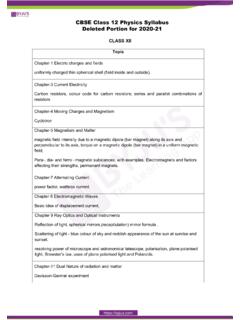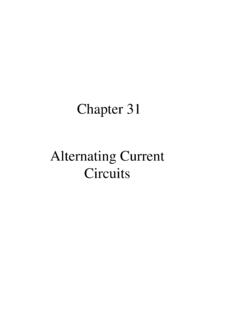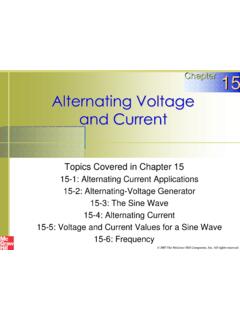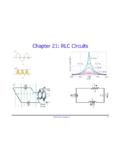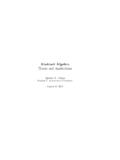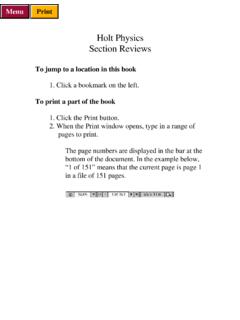Transcription of Chapter 3: Capacitors, Inductors, and Complex Impedance
1 Chapter 3: Capacitors, Inductors, and Complex Impedance - 17 - Chapter 3: Capacitors, Inductors, and Complex Impedance In this Chapter we introduce the concept of Complex resistance, or Impedance , by studying two reactive circuit elements, the capacitor and the inductor. We will study capacitors and inductors using differential equations and Fourier analysis and from these derive their Impedance . Capacitors and inductors are used primarily in circuits involving time-dependent voltages and currents, such as AC circuits. I. AC Voltages and circuits Most electronic circuits involve time-dependent voltages and currents.
2 An important class of time-dependent signal is the sinusoidal voltage (or current ), also known as an AC signal (Alternating current ). Kirchhoff s laws and Ohm s law still apply (they always apply), but one must be careful to differentiate between time-averaged and instantaneous quantities. An AC voltage (or signal) is of the form: V(t) =Vp cos( t) ( ) where is the angular frequency, Vp is the amplitude of the waveform or the peak voltage and t is the time. The angular frequency is related to the freguency (f) by =2 f and the period (T) is related to the frequency by T=1/f. Other useful voltages are also commonly defined.
3 They include the peak-to-peak voltage (Vpp) which is twice the amplitude and the RMS voltage (VRMS) which is 2/pRMSVV=. Average power in a resistive AC device is computed using RMS quantities: P=IRMSVRMS = IpVp/2. ( ) This is important enough that voltmeters and ammeters in AC mode actually return the RMS values for current and voltage. While most real world signals are not sinusoidal, AC signals are still used extensively to characterize circuits through the technique of Fourier analysis. Fourier Analysis One convenient way to characterize the rate of change of a function is to write the true function as a linear combination of a set of functions that have particularly easy characteristics to deal with analytically.
4 In this case we can consider the trigonometric functions. It turns out that we can write any function as an integral of the form () += dtVtVcos~)( ( ) where V~ and are functions of the frequency . This process is called Fourier analysis, and it means that any function can be written as an integral of simple sinusoidal Chapter 3: Capacitors, Inductors, and Complex Impedance - 18 - functions. In the case of a periodic waveform this integral becomes a sum over all the harmonics of the period ( all the integer multiplicative frequencies of the period). () +=nnn t nAtVcos)( ( ) An implication of this mathematical fact is that if we can figure out what happens when we put pure sinusoidal voltages into a linear circuit, then we will know everything about its operation even for arbitrary input voltages.
5 Complex Notation In Complex notation we replace our sinusoidal functions by exponentials to make the calculus and bookkeeping easier still. Then we can include both phase and magnitude information. We ll define i e isincos+ , ( ) where 12 i. The general procedure for using this notation is: 1. Change your problem into Complex algebra ( replace t cos with t ie) 2. Solve the problem. 3. Take the real part of the solution as your answer at the end. II. Capacitors One of the most basic rules of electronics is that circuits must be complete for currents to flow. This week, we will introduce an exception to that rule.
6 The capacitor is actually a small break in a circuit. Try measuring the resistance of a capacitor, you will find that it is an open circuit. However, at the inside ends of the capacitor s lead, it has little plates that act as charge reservoirs where it can store charge. For short times, you do not notice that the break is there. Negative charge initially flows in to one side and out from out the other side just as if the two leads were connected. For fast signals, the capacitor looks like a short-circuit. But after a while the capacitor s reservoirs fill, the current stops, and we notice that there really is a break in the circuit.
7 For slow signals, a capacitor looks like an open circuit. What is fast, and what is slow? It depends on the capacitor and the rest of the circuit. This week, you will learn how to determine fast and slow for yourselves. Capacitors serve three major roles in electrical circuits (although all three are just variations of one basic idea): Charge integrators; High or low frequency filters; DC isolators. Chapter 3: Capacitors, Inductors, and Complex Impedance - 19 - In order to perform these functions analytically, we will need to introduce a number of new concepts and some significant mathematical formalism.
8 In this process we will also develop a number of new concepts in analyzing electronic circuits. Capacitance A capacitor is a device for storing charge and electrical energy. It consists of two parallel conducting plates and some non-conducting material between the plates, as shown in figure on the right. When voltage is applied positive charge collects on one plate and negative charge collects on the other plane. Since they are attracted to each other this is a stable state until the voltage is changed again. A capacitor s charge capacity or capacitance (C) is defined as: Q=CV ( ) which relates the charge stored in the capacitor (Q) to the voltage across its leads (V).
9 Capacitance is measured in Farads (F). A Farad is a very large unit and most applications use F, nF, or pF sized devices. Many electronics components have small parasitic capacitances due to their leads and design. The capacitor also stores energy in the electric field generated by the charges on its two plates. The potential energy stored in a capacitor, with voltage V on it, is 221 CVE= ( ) We usually speak in terms of current when we analyze a circuit. By noting that the current is the rate of change of charge, we can rewrite the definition of capacitance in terms of the current as: ==IdtCQCV11 ( ) or VCdtdVCI&== ( ) This shows that we can integrate a function I(t) just by monitoring the voltage as the current charges up a capacitor, or we can differentiate a function V(t) by putting it across a capacitor, and monitoring the current flow when the voltage changes.
10 + + + + + + + + - - - - - - - - - Figure : A capacitor consist of two parallel plates which store equal and opposite amounts of charge Chapter 3: Capacitors, Inductors, and Complex Impedance - 20 - A Simple RC Circuit We will start by looking in detail at the simplest capacitive circuit, which is shown in figure on the right. An RC circuit is made by simply putting a resistor and a capacitor together as a voltage divider. We will put the resistor in first, so we can connect the capacitor to ground. By applying Kirchhoff s Laws to this circuit, we can see that: 1. The same current flows through both the resistor and the capacitor, and 2.


